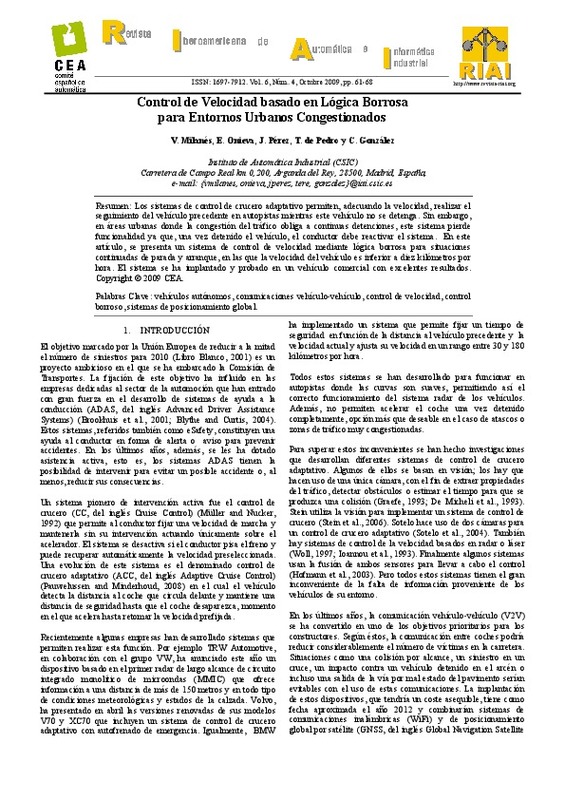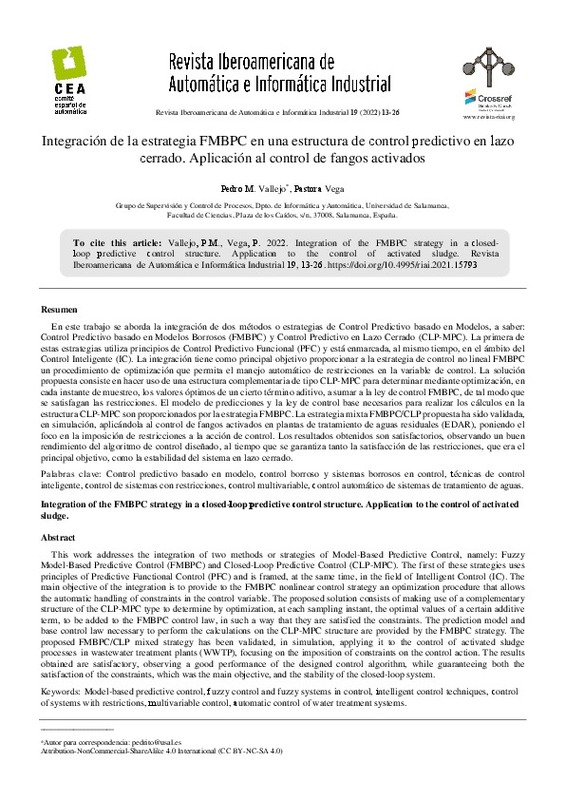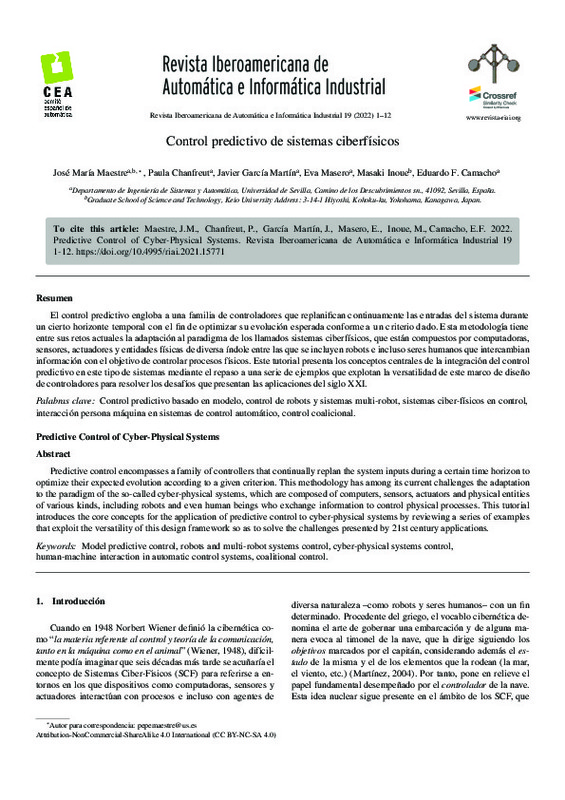JavaScript is disabled for your browser. Some features of this site may not work without it.
Buscar en RiuNet
Listar
Mi cuenta
Estadísticas
Ayuda RiuNet
Admin. UPV
Control de Velocidad basado en Lógica Borrosa para Entornos Urbanos Congestionados
Mostrar el registro sencillo del ítem
Ficheros en el ítem
| dc.contributor.author | Milanés, V.
|
es_ES |
| dc.contributor.author | Onieva, E.
|
es_ES |
| dc.contributor.author | Pérez, J.
|
es_ES |
| dc.contributor.author | de Pedro, T.
|
es_ES |
| dc.contributor.author | González, C.
|
es_ES |
| dc.date.accessioned | 2020-05-28T07:56:00Z | |
| dc.date.available | 2020-05-28T07:56:00Z | |
| dc.date.issued | 2009-10-08 | |
| dc.identifier.issn | 1697-7912 | |
| dc.identifier.uri | http://hdl.handle.net/10251/144502 | |
| dc.description.abstract | [ES] Los sistemas de control de crucero adaptativo permiten, adecuando la velocidad, realizar el seguimiento del vehículo precedente en autopistas mientras este vehículo no se detenga. Sin embargo, en áreas urbanas donde la congestión del tráfico obliga a continuas detenciones, este sistema pierde funcionalidad ya que, una vez detenido el vehículo, el conductor debe reactivar el sistema. En este artículo, se presenta un sistema de control de velocidad mediante lógica borrosa para situaciones continuadas de parada y arranque, en las que la velocidad del vehículo es inferior a diez kilómetros por hora. El sistema se ha implantado y probado en un vehículo comercial con excelentes resultados. | es_ES |
| dc.description.abstract | [EN] The adaptive cruise control systems are capable of adapting the speed to the precedent car in highways as long as the car do not stop. However, in urban areas where the traffic flow can cause stop and go manoeuvres continuously, this system is not very useful due to the necessity of re-start it once the car is stopped. In this paper, an speed control based on fuzzy logic for continuous stop and go manoeuvres is presented where the speed car is up to ten kilometres per hour. The system has been tested with two Citroën C3 vehicles, one of them full automated, in the Instituto de Automática Industrial facilities with great results. | es_ES |
| dc.description.sponsorship | Este trabajo ha sido realizado gracias a los proyectos: TRANSITO (Coordinación Local entre Vehículos e Infraestructuras), TRA 2008-06602-C03-01; ENVITE (Comunicación entre Vehículos e Infraestructuras de Transporte por Carretera incluyendo GNSS en Zonas Críticas), MFOM T7/2006; y MARTA (Movilidad y Automoción con Redes de Transportes Avanzadas), (CDTI, CENIT 2007). | es_ES |
| dc.language | Español | es_ES |
| dc.publisher | Universitat Politècnica de València | es_ES |
| dc.relation.ispartof | Revista Iberoamericana de Automática e Informática industrial | es_ES |
| dc.rights | Reconocimiento - No comercial - Sin obra derivada (by-nc-nd) | es_ES |
| dc.subject | Autonomous vehicles | es_ES |
| dc.subject | Vehicle to vehicle communications | es_ES |
| dc.subject | Speed control | es_ES |
| dc.subject | Fuzzy control | es_ES |
| dc.subject | Global positioning systems | es_ES |
| dc.subject | Vehículos autónomos | es_ES |
| dc.subject | Comunicaciones vehículo-vehículo | es_ES |
| dc.subject | Control de velocidad | es_ES |
| dc.subject | Control borroso | es_ES |
| dc.subject | Sistemas de posicionamiento global | es_ES |
| dc.title | Control de Velocidad basado en Lógica Borrosa para Entornos Urbanos Congestionados | es_ES |
| dc.title.alternative | Speed Control based on Fuzzy Logic for Traffic Jams | es_ES |
| dc.type | Artículo | es_ES |
| dc.identifier.doi | 10.1016/S1697-7912(09)70109-8 | |
| dc.relation.projectID | info:eu-repo/grantAgreement/MICINN//TRA2008-06602-C03-01/ES/COORDINACION LOCAL ENTRE VEHICULOS E INFRAESTRUCTURAS/ | es_ES |
| dc.relation.projectID | info:eu-repo/grantAgreement/MFOM//T7%2F2006/ | es_ES |
| dc.relation.projectID | info:eu-repo/grantAgreement/MITURCO//CENIT2007-1025/ES/MARTA. MOVILIDAD Y AUTOMOCIÓN CON REDES DE TRANSPORTE AVANZADAS/ | es_ES |
| dc.rights.accessRights | Abierto | es_ES |
| dc.description.bibliographicCitation | Milanés, V.; Onieva, E.; Pérez, J.; De Pedro, T.; González, C. (2009). Control de Velocidad basado en Lógica Borrosa para Entornos Urbanos Congestionados. Revista Iberoamericana de Automática e Informática industrial. 6(4):61-68. https://doi.org/10.1016/S1697-7912(09)70109-8 | es_ES |
| dc.description.accrualMethod | OJS | es_ES |
| dc.relation.publisherversion | https://doi.org/10.1016/S1697-7912(09)70109-8 | es_ES |
| dc.description.upvformatpinicio | 61 | es_ES |
| dc.description.upvformatpfin | 68 | es_ES |
| dc.type.version | info:eu-repo/semantics/publishedVersion | es_ES |
| dc.description.volume | 6 | es_ES |
| dc.description.issue | 4 | es_ES |
| dc.identifier.eissn | 1697-7920 | |
| dc.relation.pasarela | OJS\8369 | es_ES |
| dc.contributor.funder | Ministerio de Fomento | es_ES |
| dc.contributor.funder | Ministerio de Industria, Turismo y Comercio | es_ES |
| dc.contributor.funder | Ministerio de Ciencia e Innovación | es_ES |
| dc.description.references | Dragone, D. (2009). I am getting tired: Effort and fatigue in intertemporal decision-making. Journal of Economic Psychology, 30(4), 552-562. doi:10.1016/j.joep.2009.03.008 | es_ES |
| dc.description.references | Hofmann, U., Rieder, A., & Dickmanns, E. D. (2003). Radar and vision data fusion for hybrid adaptive cruise control on highways. Machine Vision and Applications, 14(1), 42-49. doi:10.1007/s00138-002-0093-y | es_ES |
| dc.description.references | Ioannou, P. A., & Chien, C. C. (1993). Autonomous intelligent cruise control. IEEE Transactions on Vehicular Technology, 42(4), 657-672. doi:10.1109/25.260745 | es_ES |
| dc.description.references | Kesting, A., Treiber, M., Schönhof, M., & Helbing, D. (2008). Adaptive cruise control design for active congestion avoidance. Transportation Research Part C: Emerging Technologies, 16(6), 668-683. doi:10.1016/j.trc.2007.12.004 | es_ES |
| dc.description.references | Lin, T.-W., Hwang, S.-L., & Green, P. A. (2009). Effects of time-gap settings of adaptive cruise control (ACC) on driving performance and subjective acceptance in a bus driving simulator. Safety Science, 47(5), 620-625. doi:10.1016/j.ssci.2008.08.004 | es_ES |
| dc.description.references | Milanés, V., González, C., Naranjo, J.E., Onieva, E. and de Pedro, T. (2009), “Eletro-hydraulic Braking System for Autonomous Vehicles” en International Journal of Automotive Technlogy, aceptado el 25 de Mayo (in press). | es_ES |
| dc.description.references | Milanés, V., Naranjo, J. E., González, C., Alonso, J., García, R., & de Pedro, T. (2008). Sistema de Posicionamiento para Vehículos Autónomos. Revista Iberoamericana de Automática e Informática Industrial RIAI, 5(4), 36-41. doi:10.1016/s1697-7912(08)70175-4 | es_ES |
| dc.description.references | Moon, S., Moon, I., & Yi, K. (2009). Design, tuning, and evaluation of a full-range adaptive cruise control system with collision avoidance. Control Engineering Practice, 17(4), 442-455. doi:10.1016/j.conengprac.2008.09.006 | es_ES |
| dc.description.references | Sheikholeslam, S. and Desoer, C.A. (1992), “Design of Decentralized Adaptive Controllers for a Class of Interconnected Nonlinear Dynamical Systems: Part I,” Department of Electrical Engineering and Computer Sciences, Institute of Transportation Studies University of California, Berkeley, CA, PATH Technical Memorandum 92-1, Febrero. | es_ES |
| dc.description.references | Sugeno, M. (1999). On stability of fuzzy systems expressed by fuzzy rules with singleton consequents. IEEE Transactions on Fuzzy Systems, 7(2), 201-224. doi:10.1109/91.755401 | es_ES |
| dc.description.references | Urmson, C., Ragusa, C., Ray, D., Anhalt, J., Bartz, D., Galatali, T., … Struble, J. (2006). A robust approach to high-speed navigation for unrehearsed desert terrain. Journal of Field Robotics, 23(8), 467-508. doi:10.1002/rob.20126 | es_ES |
| dc.description.references | Woll, J. D. (1997). Radar Based Adaptive Cruise Control for Truck Applications. SAE Technical Paper Series. doi:10.4271/973184 | es_ES |
| dc.description.references | Zadeh, L. A. (1965). Fuzzy sets. Information and Control, 8(3), 338-353. doi:10.1016/s0019-9958(65)90241-x | es_ES |











